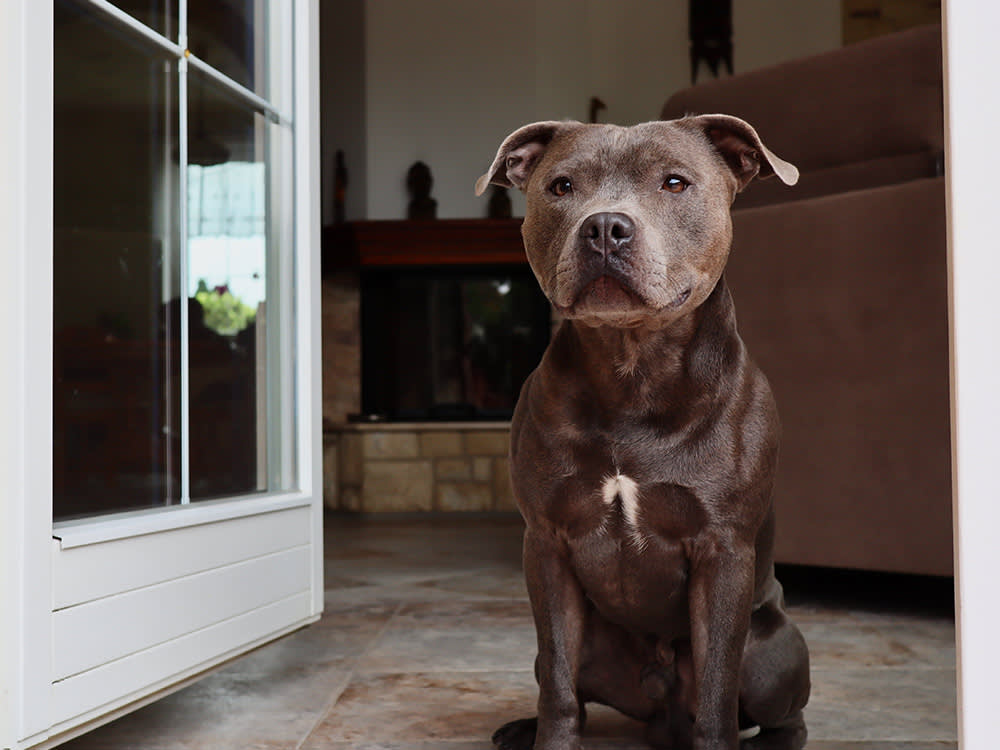Why (Certain) Dog Breeds Are Not Allowed and How to Prepare For a Move With One
Insurance companies’ breed-restriction lists take a bite out of housing options

share article

Your pet wants you to read our newsletter. (Then give them a treat.)
Discussing dog breeds is a lightning rod for controversy. Why does breed matter? Have a Chow Chow or a Doberman? — or just a dog that looks like one. Two words: breed restrictions. Some of these dog breeds have been on the bad boy list of insurance companies for years, and the pet parents who love them have been doing their best to rehabilitate their image.
Breed restrictions keep a lot of dog parents stuck between a rock and a hard place. At least a dozen breeds and their mixes are commonly found on insurance companies’ “prohibited” lists, which affects renters and homeowners. A lot of dogs would never see a shelter if their human companions were able to find housing without these rules.
According to Adam Goldfarb, the former director of HSUS’s Pets at Risk program, so many pets have lost their homes that it’s impossible to track specific breeds or breed mixes. The subprime mortgage crisis resulted in more than 4 million foreclosures in 2009, and the U.S. is facing similar economic circumstances over a decade later. We have the data for what to expect. Here’s some info on the reasons breeds are restricted, who makes those decisions, and what pet parents with these breeds can do to prepare.
Who is affected by dog breed restrictions?
“It’s more of a problem for rentersopens in a new tab than for homeowners,” Goldfarb observes. “It’s harder for renters since they don’t control the insurance used by the rental property,” much of which is run by large companies with business-wide policies in place that they’re unlikely to change. Take, for example, Parkwood Rentals in Pierce County, Wash., which handles all types of rental housing, from single-family homes to apartments and townhouses. On its breed restriction list are more than 14 breeds and their mixes. Other times, rental agencies restrict dogs simply by weight.
A 2023 survey by the American Pet Products Association showed that 38 percent of U.S. households include at least one dog, with a national average of nearly two per household. Seven of the 10 most popular breeds weigh more than 25 pounds, according to the American Kennel Club, and that’s not counting the mixed progeny of popular breeds such as Husky / Pomeranians or Doodles, which, when weight restrictions exist, are also prohibited. While only 31 percent of renters have dogs, many more would adoptopens in a new tab if not for pet restrictions.
Insurance Companies Make the Rules
Unsurprisingly, not every landlord is a dog expert. They might not even have an opinion on the matter — they’re making policies based on the breed restrictions insurance companies recommend.
“We did not compile this list,” says Katie Howard, managing broker with Parkwood Property Management, Inc. “This is the list of breed restrictions recommended by the insurance industry that we have adopted as part of our pet policy. If there is a question of breed, veterinarian certification may be required, along with pictures, references and a possible pet interview.”
Will the pet interview or a training certificate help if a potential renter’s dog is on the list or has a relative that is? Not according to Howard. “Unfortunately, we are not able to make exceptions to the breed restrictions.”
An explanation of the rationale behind the breed restrictions comes from a spokesperson for Allstate Insurance, who — in 2005, when a Washington state bill prohibiting insurance companies from banning breedsopens in a new tab failed to pass — defended her company’s position by saying, “We’re in the business of evaluating risk, and based on what we know, those dogs [on the list] pose a higher risk.” However, two states — Michigan and Pennsylvania — restrict breed profiling by insurance companies.
How did dog breeds start getting put on the no-no list?
In the U.S., breed restrictions began in the 1980s after a string of serious attacks, many said to involve Pit Bull–type dogsopens in a new tab. In 1984, Tijeras, N.M., was the first to enact a ban, which targeted Pit Bulls. As other regions followed suit, the insurance industry took note. In the 1990s, as media reports of dog attacks increased. Breed restrictions boomed, lawyers found a new specialty, and insurance underwriters scrambled to adjust their policies. But those who actually worked with dogs scratched their heads.
Goldfarb isn’t sure when the practice began in housing, but says that, in his opinion, it definitely increased leading up to the 2009 crisis. Over time, at least 75 breeds — from Dalmatians to Karelian Bear Dogs — have made the dog breed restriction lists, which vary by region and company. To make it even more confusing, breeds allowed in one place or by one insurer may be restricted in others, or by other companies.
Commonly Restricted Dog Breeds
Akitas
Alaskan Malamutes
Bulldogs
Boxers
Cane Corso
Chow Chows
Doberman Pinschers
Dalmatians
German Shepherds
Great Danes
Siberian Huskies
Mastiffs
Presa Canarios
Rottweilers
St. Bernards
“Terriers”
Wolf hybrids
And, of course, “Pit Bulls,” which can include any blocky-headed dog, including American Pit Bull Terriers, American Staffordshire Terriers, Staffordshire Terriers, American Bulldogs, and any dog who even looks like oneopens in a new tab.
Though not all insurance companies profile based on breed — State Farm are among those that don’t — those that do base their restrictions on actuarial and claims data, dog-bite reports, and state or local breed-specific laws. According to an articleopens in a new tab on Michigan State University College of Law’s Animal Legal & Historical Web Center, the use of actuarial data has been blocked by courts in some situations.
For example, when actuaries found correlations between poor minority neighborhoods and increased risk for homeowners’ claims, they stopped issuing policies in those neighborhoods, a practice known as “redlining.” In the same article, the writer states that breed discrimination is a different kettle of fish from redlining, because insurers “have been unable to demonstrate an actuarial justification for discriminating based on breed.”
Should these dog breeds be restricted?
For a lot of trainers, the list of commonly banned breeds doesn’t really make sense. “It didn’t jibe with my experience,” says Janis Bradley, formerly an instructor at the San Francisco SPCA’s Academy for Dog Trainers. Bradley, who had worked with dogs for years without incident, also talked to other trainers.
“I didn’t know anyone who had been seriously bitten by a dog,” she says. Her curiosity piqued, Bradley decided to find out what was actually going on, and started looking for facts related to this contentious subject.
In 2001, soon after she began her research, another sensational story gripped San Francisco and the nation: the mauling death of Diane Whipple by two Presa Canarios kept by Marjorie Knoller and Robert Noel. Though the case hinged on negligence rather than the breed’s aggression, the dogs were huge and the details were terrifying, and it became a touchstone for breed-ban advocates; terms Bradley calls “fear words” made headlines.
Of the many factors that lead to breed bans, she thinks reporting bias is the most influential. How — and how often — information is relayed, along with a focus on certain breeds, can distort the issue in people’s minds. Her research convinced her that perception is everything; the more we hear something, the more we believe it to be true. No breed has been proven more likely than another to bite, Bradley says, but a log she keeps of Google hits and key phrases related to bites and breeds turns up an unsurprising fact: Pit Bull and Rottweiler are the most common search terms.
Bradley, whose research provided her with material for her first book, Dogs Bite: But Balloons and Slippers Are More Dangerous, continues to track CDC bite statistics. The number of dog bites has held steady over 15 years, she says. Even so, she doubts such information will change people’s minds if they are already convinced there’s a dog-bite epidemic, or that certain breeds are more likely to bite.
“We are innately credulous if we don’t have prior knowledge of something,” she says. “The default response is to believe what we are told,” or have heard repeated time and again. Bradley feels that dog breed discrimination, like other forms of bias, won’t end without large societal changes.
Getting Away From Breed Bias
One studyopens in a new tab often cited as support for restricting these two breeds, which was a collaboration between the Centers for Disease Control and Prevention (CDC) and the American Veterinary Medical Association (AVMA), tried to link breeds with fatal bites to assess policy implications.
“It has done tremendous damage [but] there is no putting the genie back in the bottle,” Bradley says of the report, which she feels continues to be misused today. The biggest problem, she says, was its focus on fatalities which are “an extraordinarily rare event.”
Reliance on media accounts and questionable breed identification were also areas of concern. The ability to tell a bear from a deer may be a useful human survival tool, but newer studies show it hasn’t helped when it comes to breeds; people often can’t tell a Foxhound from a Doberman. Eyewitness reports were — and still are — “pretty spotty,” Golab says; in one instance, “a Boxer was identified as a Pit Bull–type dog.” Often, identification occurred after the dog had been euthanized, making it even more speculative.
Ironically, the authors of the study had hoped to prevent the discrimination they feared was taking root at the time, says co-author Dr. Gail C. Golab, director of the AVMA’s Animal Welfare Division. “The folks involved in the study had concerns that people were considering breed bans,” she recalls.
Golab goes on to note that they also had concerns about the study itself, among them, that the breeds involved in fatal attacks change over time. The study didn’t address breed popularity, a factor that could cause breeds to appear more often in bite statistics simply because there are so many of them. Another concern was that the study authors were looking at fatalities rather than bites, which are impossible to track. This meant they were unable to definitively assess any specific breed’s inclination to bite.
Though the final report did not conclude that any breeds are more likely than others to bite, it did call out Pit Bull–types and Rottweilers as being involved in more than half of the fatal attacks. Golab and her colleagues warned against using the flawed data to enact bans; the alternative to breed lawsopens in a new tab, they wrote in the report, “is to regulate individual dogs and owners on the basis of their behavior.”
At that point, the CDC abandoned its efforts to link breeds and aggression, acknowledging that it’s impossible to track the numbers. Golab says that breed discrimination existed before the study, and has gradually become more prevalent over the years.
Breed Discrimination and Pet Adoption
In contrast to the study’s narrow approach, Bradley gathered all the research then available, pulling together numbers showing that the likelihood of being killed by a dog is about one in 18 million. Or that roughly 3.9 million of the annual 4.7 million reported bites require no medical attention. Most bite victims are childrenopens in a new tab, according to the CDC.
“It certainly doesn’t help adoption rates when owners are penalized for choosing a dog of a particular breed, whether the penalty is a higher insurance rate or a flat-out refusal to insure,” Golab says. “[Restricted dog breeds] can easily end up on the least-desirable list for adoption.”
What can pet parents do about breed restrictions?
As a recession looms, pet policies with dog breed restrictions will continue to restrict housing options for people and pets in crisis. Foreclosure only adds to the problem, as people struggle to find alternative housing that will allow them to bring pets with them at all, let alone a dog of a “blacklisted” breed.
Plan Ahead
The best thing to do is be prepared, even if you feel secure in your housing right now. If pet parents can’t obtain affordable — or any — insurance because of the breed they own, they often relinquishopens in a new tab the dog; euthanasia is a common result.
Review Insurance Policies
In addition to planning ahead for a move, Goldfarb suggests homeowners do the legwork to find an insurance company that doesn’t profile based a dog breeds.
Choose Small Complexes
Renters look for an individual homeowner or smaller company, which may be open to changing their policy or making an exception. They are both ways “to encourage breed-neutral policies.”
References
American Temperament Test Society Breed Statisticsopens in a new tab
What are the different types of Pit Bulls?opens in a new tab
Pit bulls offer a lesson in community, identityopens in a new tab
9 Facts About Pit Bulls that Will Make You Go “Hmm.” Then “Awww!”opens in a new tab
Dog Breeds Most Often Banned By Home Insurance Companiesopens in a new tab
Sheila Pell
Sheila Pell is a freelance journalist who frequently writes about environmental issues. Her work has appeared in The Washington Post, Modern Farmer, San Diego Reader, The Bark, and American Forests. She lives in northern California with her husband and two large dogs.
Related articles
![]() opens in a new tab
opens in a new tabThese Organizations Support Domestic Violence Survivors and Their Pets
Learn how you can support their efforts.
![Black woman smiling and holding a Siamese cat which is looking into the camera]() opens in a new tab
opens in a new tabCARE Is Amplifying BIPOC Voices to Keep People and Pets Together
“We don’t consider what we are doing animal welfare work. We are taking a holistic approach to well-being for animals and humans.”
![A woman in a bright yellow-orange sweater holding a striped kitten in one hand and a credit card in the other while using her laptop in front of her]() opens in a new tab
opens in a new tabCan’t Pay Your Pet’s Vet Bills? These Orgs Can Help
When the bills rack up, these resources have your back.
![A woman staring at her computer while holding her dog close.]() opens in a new tab
opens in a new tab10 Things to Consider Before Adopting a Pet
It’s a big decision, so check these boxes before you sign on the dotted line.








